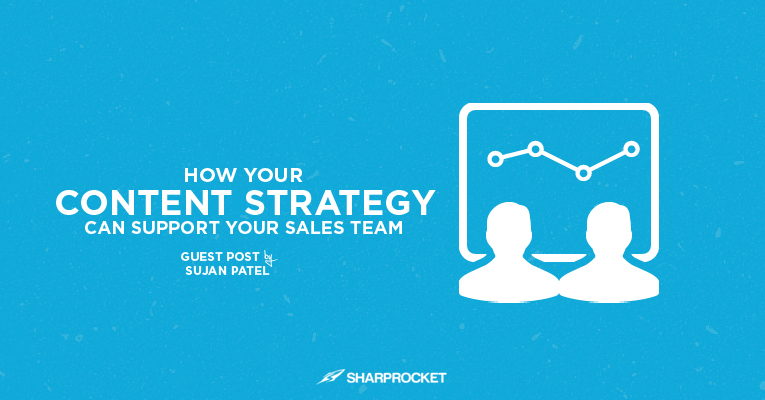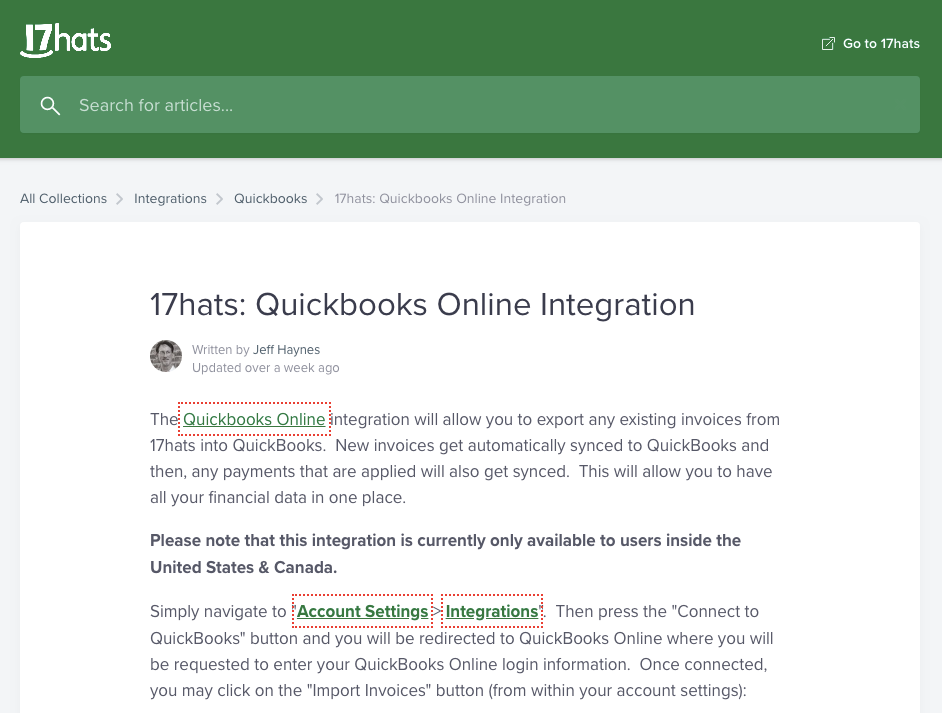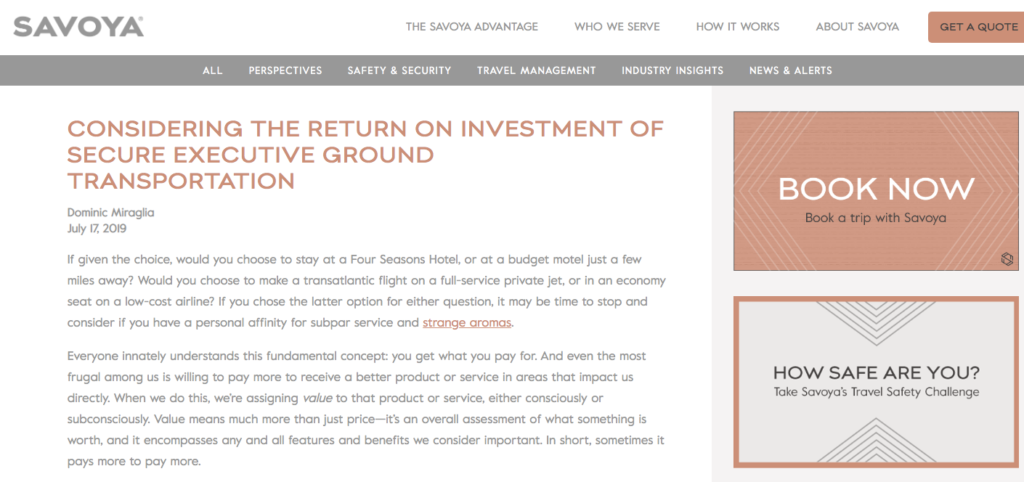by Sujan Patel | Last Updated on October 24, 2021
Whether you call it content marketing, inbound marketing, or any other related term, the use of content to advance a business’s goals almost always falls under the umbrella of marketing. But don’t pigeon-hole content. By taking a broader view of content’s potential, you can identify plenty of ways it can be used to support your sales team as well.

Marketing and sales don’t always play nice together. Marketing can execute brilliant, compelling content, but if it isn’t used by sales teams, it may not get the attention it needs to pull its weight from an ROI perspective.
Conversely, sales teams that plow forward without making use of the content assets available to them risk hamstringing their effectiveness, as more and more buyers prefer to engage with marketing content before ever connecting with a salesperson.
For your content strategy to support your sales team, you need to think about content through a broader lens. Here’s how to do it:
Understanding the Buyer Journey
If you’re going to use content to support elements of your sales cycle, you need to first understand the foundational concept of the buyer’s journey. Typically, this idea is presented in the shape of a funnel, split into different stages. Though exact funnel models vary, most include the following stages at a minimum:
- Awareness: A prospect becomes aware of a need they intend to fulfill through a purchase.
- Consideration: The prospect considers different potential solutions to their need; for instance, by evaluating your company against its competitors.
- Purchase: The prospect decides on a solution.
Some models include a post-purchase stage, while others break out the three above into more granular needs. Regardless of the specific approach, a few things hold true about funnel-based buyer journey models:
- The funnel shape is used to signify the natural attrition that occurs throughout the buyer journey. Not every prospect who becomes aware of your solution will become a customer.
- The amount of time prospects spend in the funnel depends on factors such as the significance of their need and the cost of your solution.
- Although prospects may not move through the funnel in a linear fashion, they must have their needs met at each stage before they become a customer.
Expanding on that last point, a prospect isn’t going to buy from you if they aren’t aware that they have a need to fulfill. Similarly, it’s unlikely that they’re going to buy from you without considering possible alternatives.
The good news is that, because we understand that prospects have questions that must be answered and need that must be fulfilled at each stage, we can transform these insights into content assets that can be used to support the sales team.
Here are a few strategies for doing so:
Creating Content Around Specific Product Features
In the Awareness and Consideration stages of the buyer’s journey, it’s common for prospects to have questions about specific product features.
Imagine that your company has identified a need for a new project management solution. You aren’t going to go out and sign up for the first Google result you come across. Instead, you’ll probably approach your decision in a more thoughtful way – such as by creating a list of must-have vs. nice-to-have features to guide your search.
Now, let’s assume that one of your team’s must-have features is integration with your existing CRM. Would you be more impressed by a salesperson who couldn’t give you a clear answer on whether or not their project management system integrates with your specific CRM? Or by one that can immediately send over one-pager listing popular integration, along with links to complete instructions for setting each one up?
As an example, take 17hats, a business management system for solopreneurs. The company’s help section features an extensive list of integration tutorials, including the instructions below for its Quickbooks Online integration:

There are several things you’ll want to keep in mind when creating content around specific features:
- Not all buyers will be interested in the same features. Work with your company’s sales team to identify which features the prospects they talk to are most interested in so that you can prioritize your content building efforts around them.
- Prospects prefer to access information in different ways. Will they be printing assets for future reference? Would they like to read instructions or watch them in videos? If you or your sales team aren’t clear, you may need to test a few formats to get a better feel for how to allocate your content creation efforts.
- Creating feature-specific content won’t move the needle for your sales team if you don’t also give them an easy way to access it. When they’re chasing a hot lead, few salespeople are going to stop to search for that content piece you sent across months ago. Build an easily-accessible content library, and conduct regular training on new additions so that they can put your content to work.
Creating Content Around Common Sales Objections
Your next source of sales-specific content inspiration should be the sales objections your company commonly faces.
Sales objections are the problems that keep prospects from moving forward in your sales process; they’re the reason each subsequent funnel stage is smaller than the one before it. The ability to address them successfully is a major determinant in sales success, but content can go a long way towards supporting the process.
According to Jace Ermidis in an article on the SalesForce Search blog, five of the most common sales objections encountered by teams include:
- Price, specifically because buyers “think your prices are too expensive, they can get a better price from a competitor, or they don’t have the budget.”
- Fear of changing the status quo, given the extra work a new purchase represents.
- Trust, in terms of whether or not buyers believe you can deliver what you’re promising.
- The timing of the proposal, relative to internal happenings at the company or other external events.
- The absence of a true need – whether it’s actually true that prospects don’t need what you’re selling, or whether they’re just saying that to get out of the sales process.
Opportunities exist to address each of these objections with content. For example, take a look at this blog post by Savoya, a black car service supporting executive travelers:

Understandably, executive ground transportation services are more expensive than taxis or services like Uber and Lyft. And given that the company likely faces the pricing objective on a regular basis, it’s used content pieces like this to contextualize the full value provided by the service in terms of the total ROI achieved by its customers.
You can do the same thing with sales reports. Check-in regularly with your sales team to learn what objections they’re facing most frequently. Look for opportunities to communicate your company’s responses through content, and you could take a huge amount of pressure off your salespeople by resolving the issues before conversations even begin.
Creating Content Around Customer Use Cases
Finally, use content to prove to customers that you can solve their problems by showing how you’ve done it in the past for similar clients. You may already be using gated case studies for this purpose, but don’t limit yourself to this single content type.
For instance, you could also leverage the power of use case content by:
- Inviting your top customers to contribute guest posts to your company’s blog
- Featuring them in webinars that walk through the issues they were facing and how your solution solved them
- Asking them to share a quick screen capture recording sharing what they like most about your product
- David Campbell, marketing lead at Right Inbox recommends isolating key quotes from your case studies and designing them into eye-catching social media graphics.
- Integrating use case elements into product or service description pages
- Developing a SlideShare presentation based on a customer’s story
As an example of that last strategy, check out Uniface’s case study for its customer, Synapse Innovation, which has been viewed on SlideShare more than 274,000 times:
Getting Sales Onboard with Content Marketing
As noted above, all of the content creativity in the world won’t have an impact on company performance if you can’t get sales fully onboard.
Test the strategies described above, but also test how you can best integrate your new initiative with your company’s salespeople. Do they respond best to email notifications of new content? Should you connect with them via Slack? Which content pieces seem to have the biggest impact on sales conversations, and why?
Expect that your process will evolve as you iterate based on feedback from sales and the numbers you’re seeing in your marketing analytics programs. With time, you’ll be able to adjust your content strategy and allocate your execution resources in order to properly support your sales team.
Do you take your sales team into consideration when planning your content strategy? Share any other tips or tricks you’ve learned in the comments below:
The Author
Sujan Patel
Sujan Patel is a partner at Ramp Ventures & co-founder Mailshake. He has over 15 years of marketing experience and has led the digital marketing strategy for companies like Salesforce, Mint, Intuit and many other Fortune 500 caliber companies.
How our LINK BUILDING AGENCY builds 250 links/mo consistently using Predictable Link Building Methodology™…
- Using a SIMPLE and PROVEN system
- Using a SCALABLE strategy
- No private blog networks
- No creepy outreach emails
